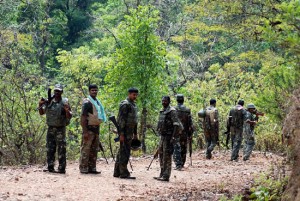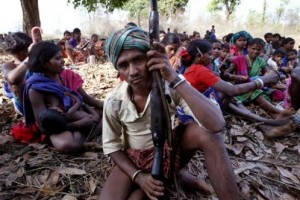Ac.Krtashivananda
Fateful day of May 2013

Naxalite Army
On May 25, 2013, members of the Congress party running the Parivartan Yatra (Change Campaign), projected as preparatory campaigning for the forthcoming state elections, travelling in a convoy of vehicles after addressing rallies in Sukma, were ambushed and killed by Naxalites. Executed were Mahendra Karma, founder and leader of the outlawed and disbanded Salwa Judum, Nand Kumar Patel, President of the Chhattisgarh Pradesh Congress Committee, his son Dinesh Patel, ex MLA Uday Mudaliyar, and others, while several others were injured, including prominent Congress state and ex-central minister Vidya Charan Shukla, ex-MLA Phulo Devi Netam. V.C. Shukla is presently undergoing treatment in Medanta Hospital in Gurgaon.
The whole incident was described in the media as a great intelligence failure. What was more surprising was the change in the route that was done at the last moment. This investigation is now in the hands of the National Investigation Agency.
On May 27, the Naxalites claimed responsibility for the attack by issuing a statement which called it a revenge for the atrocities done by the Salwa Judum. Nand Kumar Patel was suppressing people. It was in his tenure in the Center when paramilitary forces were deployed in the Bastar area. Mahendra Karma and his family have been exploiting tribals for long. They were into land grabbing and committed atrocities on tribals the statement further said. Karma was the prime target along with Nand Kumar Patel and VC Shukla but we regret killing of innocents and lower Congress functionaries.
In all 27 people were killed. Gruesome details have emerged about this meticulously planned operation. The Naxals were specifically hunting for Karma and kept asking for Karma to identify himself. This clearly suggested that the Naxals did not know much about how Karma looked and hence the belief is the Naxals were not local but from neighbouring Andhra Pradesh. Karma identified himself only to be taken afar and isolated from the convoy. Apparently, he was stabbed 78 times by 2 hardened women Naxals.
It was a show of anger against the master mind of gruesome human rights violation by the ruling class under the patronage of Mahender Karma himself a tribal leader.
Background

India’s Red Army
The Naxalite–Maoist insurgency is an ongoing conflict between Maoist groups, known as Naxalites or Naxals, and the Indian government. The conflict in its present form began after the 2004 formation of the CPI-Maoists, a rebel group composed of the PWG (People’s War Group), and the MCC (Maoist Communist Centre). In January 2005 talks between the Andhra Pradesh state government and the CPI-Maoists broke down and the rebels accused authorities of not addressing their demands for a written truce, release of prisoners and redistribution of land. The ongoing conflict has taken place over a vast territory (around half of India’s 28 states) with hundreds of people being killed annually in clashes between the CPI-Maoists and the government every year since 2005.In addition the CPA-Maoists have specifically targeted civilians during the conflict, a practice that has resulted in hundreds of deaths every year since 2006.
The armed wing of the Naxalite–Maoists is called the PLGA (Peoples Liberation Guerrilla Army) and is estimated to have between 6,500 and 9,500 cadres, mostly armed with small arms.
The Naxalites control territory throughout Bihar, Jharkand and Andhra Pradesh states and claim to be supported by the poorest of the rural population, especially the Adivasis.(tribals). The Naxalites have frequently targeted tribal, police and government workers in what they say is a fight for improved land rights and more jobs for neglected agricultural labourers and the poor. The Naxalites claim that they are following a strategy of rural rebellion similar to a protracted people’s war against the government.
COUTER INSURGENCY PLAN OF THE INDIAN GOVERNMENT
Salwa Judum (1) emerged in 2006, as a people’s resistance movement against the Naxalites, a far-left movement with Maoist ideology in some states in rural India that is designated by India as a terrorist organization on account of their violent activities. It was claimed by the govt. as an uprising of local indigenous people in Chhattisgarh, the movement later received bi-partisan support from both the ruling and opposition parties. A few years later the state government adopted the Salwa Judum movement in order to counter Naxalites in regions where they had established themselves by force.
In 2008, Chhattisgarh along with neighboring Jharkhand accounted for over 65% of the total Naxal violence in the country. Chhattisgarh state had trained a number of ‘Special Police Officers’ or SPOs (also commonly referred to as Koya commandos), from amongst the tribals who were part of Salwa Judum.
With success of counter-strikes on Naxalite hideouts in south Chhattisgarh, Maoist activities in the bordering districts of Orissa saw a rise in 2008, thus in Feb 2009, the Central government announced its plans for simultaneous, co-ordinated counter-operations in all Maoist extremism-hit states – Chhattisgarh, Orissa, Andhra Pradesh, Maharashtra, Jharkhand, Bihar, UP and West Bengal, to plug all possible escape routes of Naxalites.
History
The first movement against the Naxalites was the ‘Jan Jagran Abhiyan’, started in 1991 by Mahendra Karma, a local tribal Congress leader. This was mostly led by local traders and businessmen. This collapsed, and the leaders had to seek police protection. However, the second time around, the state had signed the mining agreements with the Tata and Essar groups, and was eager to flush the region of the Naxalites in order let the mining companies smoothly operate there. This was the beginning of police and military support to the movement. Mahendra Karma, a Congress Member of the Legislative Assembly (MLA) and the leader of opposition in the State Legislative Assembly became the public front and took the Bijapur-based movement to Dantewada, Katreli and other parts of the region.
Salwa Judum herded villagers and tribals in makeshift camps, where human rights abuses were rife. Salwa Judum became increasingly violent and out of control. Salwa Judum is also accused of burning and evacuating out 644 or more villages, making 300,000 people flee their homes. As the situation further escalated in the coming years, Human Rights Watch reported atrocities at both ends, and reported large scale displacement of the civilian population caught in the conflict between the Naxalites and Salwa Judum activists with at least 100,000 people moving to various camps in southern Chhattisgarh or fleeing to neighbouring Andhra Pradesh as of early 2008. By mid-2008 the figure grew to 150,000 tribals being displaced. There was also widespread report of rape and other abuses on women by the Judum.
The Chhattisgarh state Police employs tribal youths as SPOs (Special Police Officers), which are essentially 4,000 youth, both ex-Naxalites and those drawn from Salwa Judum camps in the Bastar region, who are paid an honorarium of Rs 1,500 (Rs 3000 in 2011)per month by the state government, were trained by with mostly .303 rifles. In Feb 2009, the Supreme Court in India declared such arming of civilians illegal.
Human rights violation
Some human rights organizations such as the People’s Union for Civil Liberties has raised allegations against Salwa Judum. A fact finding commission of National Human Rights Commission of India (NHRC), appointed by Supreme Court of India reported that Salwa Judum was a “spontaneous reaction by the tribals to defend themselves against the “reign of terror unleashed by the Naxalites.” The report was submitted to honourable Supreme Court of Indiawhich, on the contrary, declared Salwa Judum to be illegal and unconstitutional, and ordered its disbanding. This clearly raises doubts against the neutrality of the NHRC commission whose report stood in strong support of Salwa Judum.
State sponsoring of militia
In April 2008, a Supreme Court bench directed the state Government to refrain from allegedly supporting and encouraging the Salwa Judum: “It is a question of law and order. You cannot give arms to somebody (a civilian) and allow him to kill. You will be an abettor of the offence under Section 302 of the Indian Penal Code.”; the state government had earlier denied, Salwa Judum being a state-sponsored movement, later it directed the state government to take up the remedial measures suggested in the NHRC earlier report . The Human Rights Commission alleged that Security forces collaborated with Salwa Judum in their fight against the Maoists.
In December 2008, replying to a petition filed in the Supreme Court, the state government acknowledged that Salwa Judum and security forces had burnt houses and looted property but the allegations against Salwa Judum of killings though the National Human Rights Commission reported on the contrary.. In an order, the Supreme Court mentioned that people take arms for survival and against inhuman implementation of law depriving the weak, and not senselessly. The court pointed out the importance of formalized state police actions, in ways that do not ignore Constitutional values:
“Given humanity’s collective experience with unchecked power, which becomes its own principle and its practice its own raison d’etre, resulting in the eventual de- humanisation of all the people, the scouring of the earth by the unquenchable thirst for natural resources by imperialist powers, and the horrors of two World Wars, modern Constitutionalism posits that no wielder of power should be allowed to claim the right to perpetrate the state’s violence against any one, much less its own citizens, unchecked by law, and notions of innate human dignity of every individual.”
1. Salwa Judum (meaning “Peace March” or “Purification Hunt” in Gondi language) was a civilian militia mobilised and deployed as part of anti-insurgency operations in Chhattisgarh, India, aimed at countering Naxalite violence in the region. The militia consisting of local tribal youth received support and training from the Chhattisgarh state government.[1][2] (http://en.wikipedia.org/wiki/Salwa_Judum)


